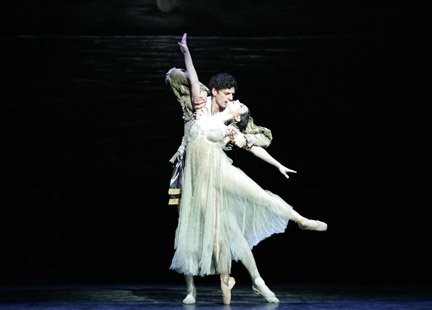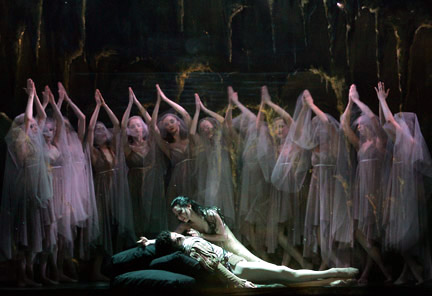Water Magic
"Ondine”
The Royal Ballet
Royal Opera House, Covent Garden
London
April 19 – May 24, 2005
by
John Percival
copyright
©2005 by John Percival
 Although
Frederick Ashton invented the three-act ballet as far as British choreography
was concerned, he practised that form for only one decade, 1948-58. When
the last example, “Ondine”, was new, some people were so unimpressed
that one friend bet me it would have vanished within five years. That
was 47 years ago and here we are still enjoying it (but did I ever collect
my winnings? Too late now.)
Although
Frederick Ashton invented the three-act ballet as far as British choreography
was concerned, he practised that form for only one decade, 1948-58. When
the last example, “Ondine”, was new, some people were so unimpressed
that one friend bet me it would have vanished within five years. That
was 47 years ago and here we are still enjoying it (but did I ever collect
my winnings? Too late now.)
What put people off, I think, was primarily the score. Hans Werner Henze was then a youngish composer, just past 30, born in Germany, living in Italy, little known in Britain, and some found his music heavy going. But he had long wanted to work with Ashton (since seeing “Scènes de ballet”), gladly accepted the choreographer’s very detailed minute-by-minute scenario, and came to London to write the score in close collaboration. Heard now, it is a fine ballet score, dramatic and danceable.
Not everybody liked the plot, either. Although a love story, the fact that it involved mythical creatures, sea-sprites, could be a problem. Yet we happily accept wood-nymphs in “La Sylphide”, not to mention princesses turned into swans or sleeping for a century. And there were precedents from the romantic period for “Ondine”, from Perrot and Paul Taglioni. Besides, Ashton made his characters so plausible, so quasi-human in fact, that personally I find the result a lot more real and convincing than supposedly realistic works such as the falsified Russian history of MacMillan’s “Anastasia” or his fake Austria-Hungary in “Mayerling”. Ashton’s creation was inspired by his love of the sea, the surge and swell of waves, a love shared by his original protagonist in 1958, Margot Fonteyn. And not since Fonteyn has there been a replacement so apt as Tamara Rojo, dancing the premiere of this revival. The smooth flow of her movement and the sensitivity of her response to Henze’s expressively colourful music combine with the deep sincerity of her interpretation to bring the character of the adored water nymph credibly to life. She is conceived as literally without a heart (note her surprise on first feeling the heartbeat of her admirer Palemon) but not at all “heartless”—a most touching, entirely convincing performance and, as always with Rojo, beautifully danced. At the second performance Alina Cojocaru took the role: not quite so splendid in the many small quick steps, but finding a nice sense of drama for the later scenes.
Rojo had a caring Palemon in Jonathan Cope, a fine partner and dancing rather well too. Cojocaru’s partner (making his debut, as was she) was Federico Bonelli, who is becoming apt to the Ashton style in this, his second Royal Ballet season, and gave a really good first sketch of the tricky role (emotionally, although not physically, he sometimes recalled the first Palemon, Michael Somes). Tirrenio, Lord of the Mediterranean Sea, is a difficult part to cast, since it was made to show off Alexander Grant’s unique mixture of gifts, classical virtuosity and flair for characterisation; but although Ricardo Cervera could usefully suggest a little more anger he dances his solos amazingly well, and his alternate, Martin Harvey, coped better than his other roles might have suggested. And the character divertissement in Act III resumes much of its old brilliance. José Martín stood out in one cast, and Laura Morera in another; too bad they were not cast together.
There is, besides, a very great deal of demanding ensemble dancing for the corps de ballet, and "Ondine" continues the influence of the other Ashton ballets in this highly welcome centenary season, inspiring the whole Royal Ballet company to a effort that makes them look better than they have done in years. I have it on the best authority that they find the dances difficult, with their speed, their many small fast steps, and the contrast between legs and upper body, but the effort is certainly doing them a lot of good. Richard Bernas conducts enthusiastically, and with Lila de Nobili’s imaginative designs, the only serious complaint (as too often lately) is excessive gloom in John B. Read’s lighting, which also suffered poor detail in timing and placing.
 This
Ashton season has gone so well under Monica Mason’s direction that
her acceptance of an invitation to extend her contract until 2010 is good
news. Her programming for the 2005-6 season inevitably includes some of
the box office draws such as “Manon”, “Nutcracker”,
“Romeo” which might have done with a longer rest. However,
further performances of Ashton’s “Sylvia”, “Marguerite
and Armand” and “Fille” are scheduled, besides the restoration
of his “Les Rendezvous” and “La Valse” (and, after
long absence, Andrée Howard’s “La Fete étrange”).
New to the company’s repertoire are “La Sylphide” (to
be produced by Johan Kobborg), Flemming Flindt’s “The Lesson”
and Glen Tetley’s “Pierrot Lunaire” (marking his 80th
birthday—I would have preferred, for a change “Dances of Albion”
which he created for Covent Garden). Two young choreographers who have
made works in the Royal Opera House’s Linbury Studio theatre, RB
dancer Alastair Marriott and Canadian Matjash Mrozewski, will show creations
on the main stage. Best of all, perhaps, are two bills in May and June
2006 to celebrate the Royal Ballet’s 75th anniversary (on the actual
birthday date, 5 May, there will be a performance of “Fille”).
First, Mason and former ballet master Christopher Newton, plus designer
Peter Farmer, will be responsible for a new production of “The Sleeping
Beauty” based on the historic 1946 staging by Nicholas Sergeyev,
Ninette de Valois and Oliver Messel. Following that, a revival of de Valois’s
“The Rake’s Progress” will open a programme including
divertissements (some MacMillan is promised, and perhaps Cranko) and a
new version of “Homage to the Queen”. That was made by Ashton
in 1953 and premiered on Queen Elizabeth’s coronation day, featuring
four ballerinas, Fonteyn, Beryl Grey, Violetta Elvin and Nadia Nerina
paying their respects as the four elements, with strong supporting cast.
The revival will honour the Queen’s 80th birthday. Since only parts
of the original choreography survive, Ashton’s “Air”,
made for Fonteyn and Somes, plus the restored entrée and apotheosis,
will be given with three new episodes by, it is hoped, David Bintley,
Michael Corder and Christopher Wheeldon.
This
Ashton season has gone so well under Monica Mason’s direction that
her acceptance of an invitation to extend her contract until 2010 is good
news. Her programming for the 2005-6 season inevitably includes some of
the box office draws such as “Manon”, “Nutcracker”,
“Romeo” which might have done with a longer rest. However,
further performances of Ashton’s “Sylvia”, “Marguerite
and Armand” and “Fille” are scheduled, besides the restoration
of his “Les Rendezvous” and “La Valse” (and, after
long absence, Andrée Howard’s “La Fete étrange”).
New to the company’s repertoire are “La Sylphide” (to
be produced by Johan Kobborg), Flemming Flindt’s “The Lesson”
and Glen Tetley’s “Pierrot Lunaire” (marking his 80th
birthday—I would have preferred, for a change “Dances of Albion”
which he created for Covent Garden). Two young choreographers who have
made works in the Royal Opera House’s Linbury Studio theatre, RB
dancer Alastair Marriott and Canadian Matjash Mrozewski, will show creations
on the main stage. Best of all, perhaps, are two bills in May and June
2006 to celebrate the Royal Ballet’s 75th anniversary (on the actual
birthday date, 5 May, there will be a performance of “Fille”).
First, Mason and former ballet master Christopher Newton, plus designer
Peter Farmer, will be responsible for a new production of “The Sleeping
Beauty” based on the historic 1946 staging by Nicholas Sergeyev,
Ninette de Valois and Oliver Messel. Following that, a revival of de Valois’s
“The Rake’s Progress” will open a programme including
divertissements (some MacMillan is promised, and perhaps Cranko) and a
new version of “Homage to the Queen”. That was made by Ashton
in 1953 and premiered on Queen Elizabeth’s coronation day, featuring
four ballerinas, Fonteyn, Beryl Grey, Violetta Elvin and Nadia Nerina
paying their respects as the four elements, with strong supporting cast.
The revival will honour the Queen’s 80th birthday. Since only parts
of the original choreography survive, Ashton’s “Air”,
made for Fonteyn and Somes, plus the restored entrée and apotheosis,
will be given with three new episodes by, it is hoped, David Bintley,
Michael Corder and Christopher Wheeldon.
Photos:
First: Tamara Rojo (Ondine) and Jonathan Cope (Palemon) in Sir Frederick
Ashton's "Ondine." Photo by Johan Persson.
Second: Tamara Rojo (Ondine) and Jonathan Cope (Palemon) and Artists
of the Royal Ballet in Sir Frederick Ashton's "Ondine."
Photo by Johan Persson
Volume 3,
No. 16
April 25, 2005
copyright
©2005
John Percival
www.danceviewtimes.com
|
|